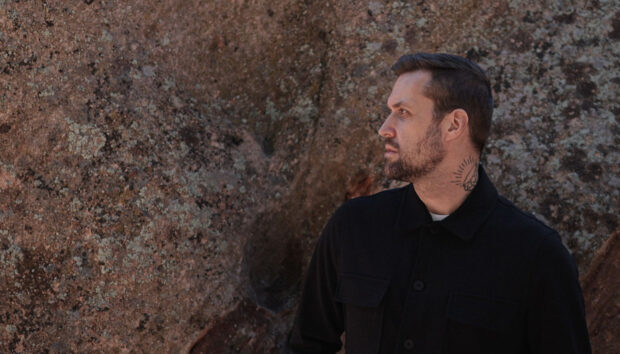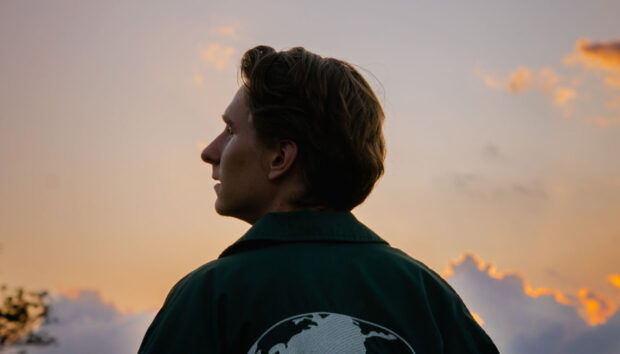
Although he has been producing club-orientated music since the turn of the century, Australian producer Rick Bull recently changed his approach to sound. Known to many as Deepchild, with album releases on Future Classic and Thoughtless Music, Bull recently unearthed his new, ambient alias Acharné, with a self-released body of music entitled Innocence and Suburbia. Discussing his new sonic aesthetic and change in approach to composition, here Bull provides his case for working towards the imperfect sound.
How would you describe the sound aesthetic you created with Acharné?
Acharné is a project which ostensibly explores notions of silence, memory, and amnesia, employing basic tools and techniques to construct a space which (to paraphrase the late, great Mark Fisher) is essentially ‘hauntological’ or hypnagogic. In other words, a lot of the sound design explores processing, smearing, recutting, and editing sound material which may be familiar or known, and seeks to unpack, montage, and disrupt it. A lot of my source material is constructed from reverb trails, the spaces between notes in well-known works, audio detritus, clicks, pops, and field recordings which hold meaning for me. Wounded audio, I guess. I feel uncomfortable with perfection.
Musically, so many of my ideas are really simple counterpoint motifs, composed of textures embedded within existing recordings (e.g. the reverb tail from a John Cage piano note, or the fading sibilance from an Adele vocal), looped and placed in artificial space. Lowpass filters, reverbs, over-compressed mp4 rips: I’m interested in sounds which betray their source more than a little because I think that the medium really is the message. Fake news has a lot to teach us.
Perhaps in some sense, it’s a sound aesthetic reacting to the tropes of ‘realism’ or ‘authenticity’, which are the byproducts of the neoliberal sound machine. I’m not interested in the sound of a ‘real 808’, or ‘old-school’ house or techno, or ‘authentic’ tape saturation. These technologies were so vital because they sprung from a time when the ‘future’ was still being invented, and so often now we look ‘back to the future’ which never came to pass.
I’ve tried to compose ideas which leave room for imagination, improvement and development
How was the studio approach different from the music you produced as Deepchild?
My life in house and techno has been a charmed one, and it still poses so many challenges to me as a producer. Things that seem so intuitive to other producers of dance music have often felt like more of a challenge to me. And yet, I’ve still managed some incredible bookings, remixes, and opportunities over the last 20 years. Acharné, on the other hand, felt like a much needed counter-balance to clubland. Standing back in the context of Berlin, I realized that some elements of the techno world had become so self-conscious, dogmatic, and aspirational, and I started to feel quite affected by this.
The Acharné process is looser, simpler, more direct. Tracks are shorter in duration, ‘through written’, and a bit more of a ‘guilty pleasure’. I find a sound. I make a loop. I layer it up. I bash it into shape. I limit arrangements to no more than eight tracks. Render. Forget. Often, tracks end up as composites of little ‘sketches’ or textures composed on trains, in transit, on tour, wherever. I guess it might be considered an exercise in process, divorced of any commercial imperative whatsoever. A reminder of why I began composing in the first place: as a way of making sense of a world which felt too complex. A way of making my own sonic lexicon.
Tracks are almost entirely composed of audio samples, looped roughly, or just placed on a timeline where they ‘felt’ good, rather than where they made structural sense. A compressor and EQ on every track, two-effects returns. If there are unintentional clicks, pops, dynamic changes, I’ve generally just left them in there as reminders of the ‘process’.
Was it a different way of writing music?
It felt like an experiment in trying to write a lot less self-critically, and more intuitively. An exercise in surrender and intentionality. If an idea sounds ‘imperfect’, I’ve tried to exploit it. Crucially, it’s also been a project heavily reliant on collaboration with my mastering engineer in Canada (Jay at Jedi Mastering). I’ve always felt like my mixes are a little undercooked, and with Acharné, I’ve offered over material to him to make mixing and mastering decisions which may seem ‘radical’ in a more orthodox context. If material feels like it requires radical retooling to make sense, I’ve asked Jay to smash it into shape, and sacrifice whatever is necessary to maintain a sense of ‘vibe’. Brevity, levity, simplicity, and playfulness are the markers of ‘success’ here. Functionality is secondary. I’ve tried to compose ideas which leave room for imagination, improvement, and development. The entire album project is really a ‘work in progress’, rather than a definitive statement. It’s a series of questions, and I’ve tried to include others in this process as much as possible.
How do you typically find yourself starting a track?
Tracks are usually sparked by memory. Acharné is, in part, an exercise in sonic archeology. If I’m at the gym and Days Of Our Lives is broadcast on the TV, why do I feel frightened? How is it that Paris Is Burning, or recordings of Nixon from the Watergate tapes still make me feel hyper-vigilant? I’m never quite sure.
Work starts by downloading these kinds of recordings, and picking them apart. Listening to them on repeat, until something of the fear or emotional charge dissipates. Zooming in on recordings, picking a sound or motif (you may have heard segments from a Maybelline commercial in a few of my tracks), and extrapolating these into motifs or tonal colors. Find the sounds which frighten you. Make them your own. Tell a different story. A better future.
What tools and effects did you use to create the granular, moody aesthetic?
I use a lot of tools in Ableton Live, like the Simpler instrument. I’m a big fan of granular synthesis – of zooming right into a larger sound, and looping or extrapolating a tiny segment of it into something unique, while having established a sense of ‘ownership’ with whatever the original source material might have once been.
I use low-pass filters on almost everything; saturation and compression to foreground sonic artifacts, and tones of side-chain compression to clear space. There’s a fair degree of material generated from user patches in the Native Instruments Reaktor library. I’m hopeless at programming synthesizer patches with any efficacy, but I love the idea of unearthing little sonic ‘stories’ from others which might have been forgotten, usurped, or made redundant over the years. I’m obsessed by the early 00s, when ‘open source’ sound design felt so exciting, before ‘DJ-optimized’ sample tools and packs became ubiquitous. I’m smitten by the gigabytes of ‘forgotten’ patches made by the user community at NI, so I love playing with these to this day. It’s another portal into a past I’m slowly making sense of.
Can you give specific examples of the REAKTOR libraries you used?
Synth-in-case for deadly modular experimentation; Metaphysical Function, which is drone central; and Prism.
Are there specific plug-ins, or VSTs you always go back to?
Native Instruments Reaktor, PSP Vintage Warmer for compression, PSP Xenon for limiting. The rest I’ve either never been able to afford, or have lost, or don’t have a machine fast enough to run. It’s remarkable how much compatibility and cross-grade options have informed my choices. My computer is inevitably five or six years behind the latest model, and this often creates some welcome challenges.
If the process isn’t simple, I’ll happily let go of these tools. Some of my favorite VSTs are old 32-bit plugins which I purchased for $20 or less.

How do you process vocals / samples?
Similarly to any other instrument. Generally overcompressed, low-pass filtered, broken, or poorly warped. I use Antares Auto-Tune from time to time. The ‘formant’ filter is quite lovely. Any tool which generates artifacts or anomalies is an added bonus for me.
How do you approach the balance between hardware and software when it comes to production?
Most of my hardware is now in bubble-wrap or was given away due to moving house. I’m terrible at selling things I love. I prefer to offload them to loving homes, in general.
I tend to feel that if ‘everyone’ is grabbing a certain piece of hardware, I should probably avoid it. The big surprise to me in the past few years has been the Roland TR-8, to be honest. Ugly as hell, but gorgeously user-friendly and programmable. I use it constantly in live Deepchild sets. If I become overly attached to something, I do feel it’s important to give it away, however, or there’s a real chance that its spirit will become a poltergeist, undead and calcified in sentimentality. And sentimentality feels deeply problematic to me.
What did you learn from making music this way?
Instruments, tools, and collateral are inherently ‘classist’ in a sense. Whilst it’s great to own a TR-808, if this is the only tool you use, you’ll probably end up sounding similar to so many others in your class. I believe the future that these tools were once indicative of was so much more exciting though. There’s safety in the known, but the future I come from was once such a beautifully unknown place. I’d love to end up there.
photo credits: We Own Cameras















